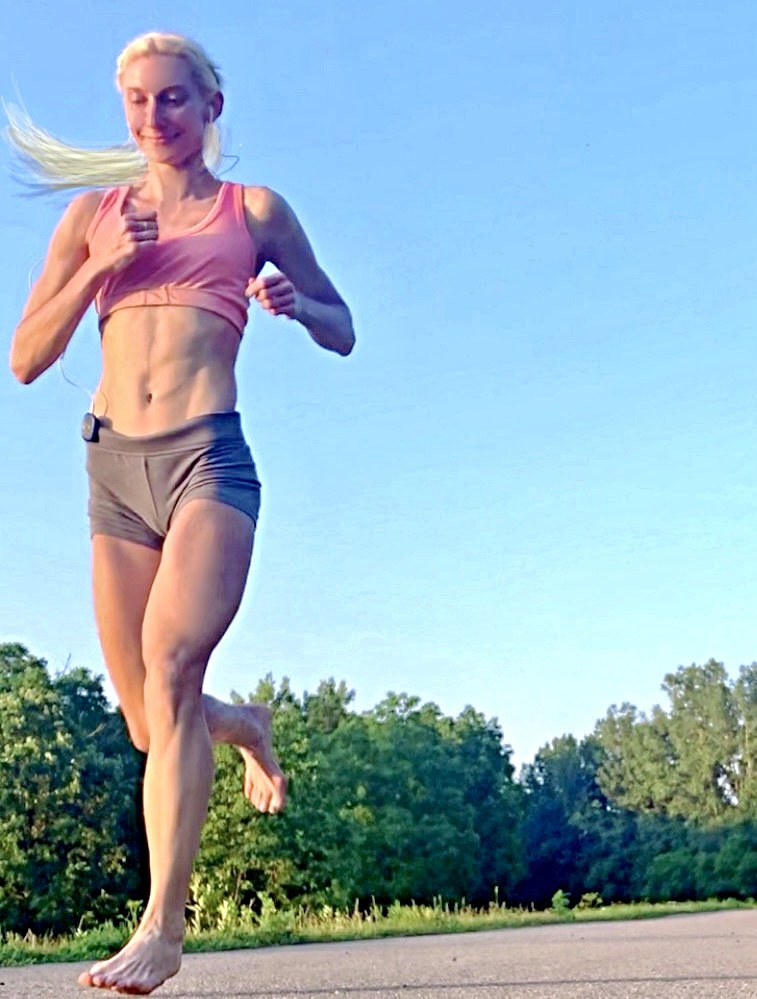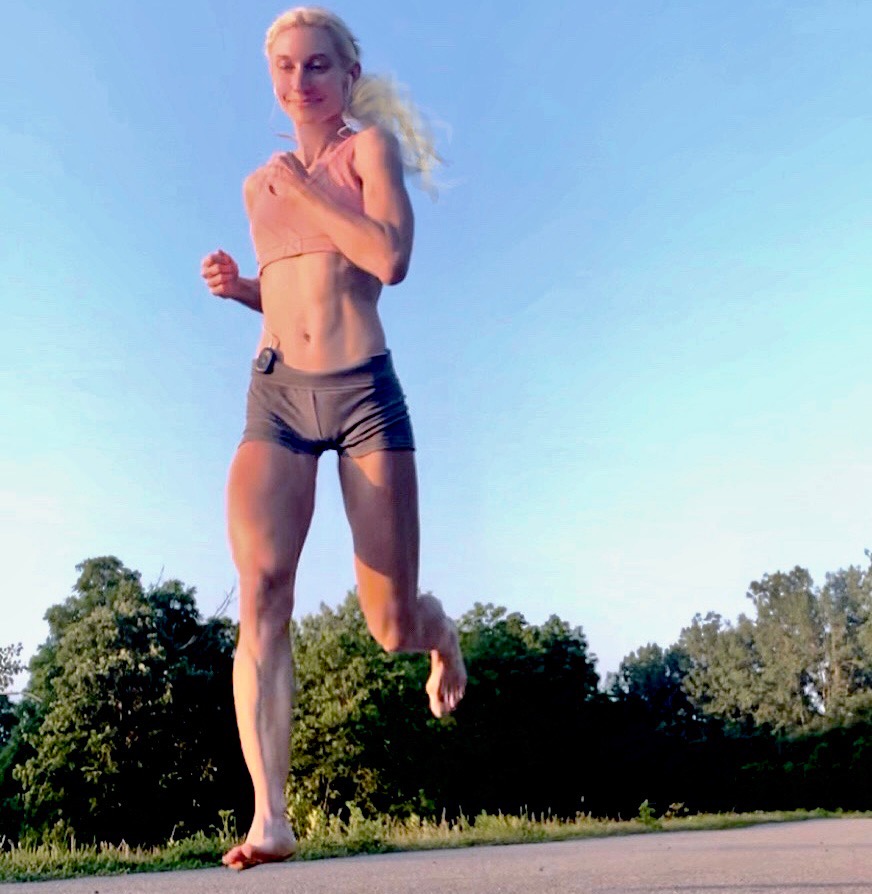Barefoot running is not only healthier for the feet because it provides the only stimuli that directly strengthens the bones, muscles, soft tissues, tendons, nerves and blood vessels in the feet, barefoot running also corrects abnormal foot motions and postures, such as over-pronation, too!
Foot pronation is the natural side-to-side motions of the back of the foot during the touchdown and stance phases of running. Its considered part of the body’s built-it natural mechanical support and impact protection. However, too much or too little foot pronation, especially too much pronation during running, has been found to amplify impact and increase bending strain, rotational stress and torque on the leg, especially the knee!
Essentially, over-pronation means the foot wrestles with the ground too much during running and its usually the result of weak pronatory muscles in the foot. Landing with a heel strike when running also causes overpronation because the heel-to-toe movement path forces the foot pronate more, however forefoot running, especially when barefoot, was found to prevent overpronation.

There’s well-supported data showing that foot pronation patterns differ between heel strike running and forefoot strike running, and that foot pronation is most stable in barefoot conditions than in cushioned shoes because there’s less mechanical interference under the foot!
Why Foot Pronation is Optimized in Forefoot Running
In a forefoot strike landing during running, the foot actually operates from a safer pronation pattern, making forefoot striking an important asset in protecting the lower leg from injury as compared with heel strike running.
Here’s the typical pronation pattern in a forefoot strike:

A. Prior to touchdown in forefoot running, the forefoot begins to invert (tilts outward away from the midline).
- Forefoot inversion (the forefoot tilts outward to set up to land under the 4th-5th toes) upon and at touchdown allows more control of the foot until the heel is lowered to the ground and was found to be a protective mechanism in minimizing impact at the heel.
The increased forefoot inversion upon and at touchdown is followed by rapid forefoot eversion (the inner side of the forefoot begins to make contact with the ground, shown in B).
- Rapid forefoot eversion facilitates arch lowering, allowing the foot to become more mobile which in turn makes the arch better at attenuating shock.
B-C . The forefoot and heel begins to move relative to each other and the heel lowers down to the ground, initiating stance.
- During stance, the heel supinates (the ankle bows outward away from the midline) when barefoot whereas in cushioned running shoes, the rearfoot (heel) angle decreases, suggesting that when heel supination is blocked via running shoes during stance, interferes with the natural, preferred pronatory movement path of the foot. In this way, shock attenuation is impaired, projecting more impact onto the leg.
D. The foot is quickly removed as soon as the center of mass moves more anteriorly.
In looking at the whole picture of how the foot interacts with the ground in forefoot running, especially when running barefoot, the precise movement path of the foot provides sturdier dynamic stability of the foot-ankle complex and keeps the kinetic chain aligned in a safer range of tolerance, giving you optimal level of protection from damaging impact and other physical stressors.
Last but not least, as mentioned above, foot strike isn’t the only variable that influences foot pronation. Footwear does, too! Stacoff et al. (1991) found that during stance, footwear forced the rearfoot into extreme positions as compared with barefoot running, which is more evidence against the effectiveness of running shoes in injury prevention!
Another way forefoot running, especially when barefoot, prevents over-pronation and keeps pronation within a safer range is by increasing cadence (the number of steps taken per minute) as compared with heel strike running heel strike running.

How Heel Strike Running and Overpronation Get Linked Together
In heel strike running, especially in thicker cushioned running shoes, cadence is measurably lower because ground-contact time is much longer. This results in more time for the foot to be pushed away from its neutral order and for over-pronation to occur.
What is it about heel striking during running that causes the foot to overpronate?
The movement path of the foot on the ground in heel strike running is the reverse of forefoot running. Unlike forefoot running, the heel spends more time in an extreme everted position in heel strike running, which was found to increase ankle instability and increase torque on the lower leg at landing. In contrast, in forefoot running, forefoot inversion at touchdown accelerates ankle stability at landing which enabled sturdier balance.
Another mechanical conflict at the feet in heel strike running is the trajectory of the center of pressure on the foot during the heel-to-toe rollover phase causes excessive toe-out which over-strains the mid-foot. In this position, the foot’s arch also has a greater tendency to collapse as the body weight passes posterior to anterior over the foot (McClay and Manal 1998).
The Take Home Message
It’s good to see more research assessing the major differences between heel strike and forefoot strike running, and that these differences reinforce the fact that foot strike pattern does matter in running!
The evidence is also building, proving that conventional running shoes cause more harm than good by forcing the foot to pronate more, and that barefoot running engages steadier footsteps by strengthening the foot’s pronatory muscles and by engaging a forefoot strike as well as higher cadence.
In that regard, here is more research showing that when it comes to optimizing your forefoot running form, its best to do so with barefoot running and that the more you run barefoot, the better you are at upholding proper forefoot running form for if you choose to run in shoes!
References:
McClay I and Mana K. A comparison of three-dimensional lower extremity kinematics during running between excessive pronators and normals. Clin Biomech, 1998; 13(3):195-203.
Stacoff A, Kalen X and Stussi E. The effects of shoes on the torsion and rearfoot motion in running. Med Sci Sports Exer, 1991; 23(4):482-490.
If you’d like, you can support Run Forefoot and help keep it going by making a donation in any amount of your choosing:

Or, you can also support Run Forefoot by shopping at the following top minimalist shoes brands, and be sure to bookmark the links:
Be Lenka: https://www.dpbolvw.net/click-7600968-14330828
FeelGrounds: https://www.feelgrounds.com/?p=RunForefoot
Xero Shoes: https://xeroshoes.com/go/Run_Forefoot
Iguaneye: https://www.iguaneye.com/?ref=8tfXVc92
Soft Star Shoes: https://shrsl.com/3mp1b
Wilding Shoes: https://bit.ly/3lIygQP
Earth Runners: https://earthrunners.com/?rfsn=6763579.f7f9c9
Vivobarefoot: https://shrsl.com/3kvih
Zappos: https://goo.gl/J1CeAd

Bretta Riches
BSc Neurobiology; MSc Biomechanics candidate, ultra minimalist runner & founder of RunForefoot. I was a heel striker, always injured. I was inspired by the great Tirunesh Dibaba to try forefoot running. Now, I'm injury free. This is why I launched Run Forefoot, to advocate the health & performance benefits of forefoot running and to raise awareness on the dangers of heel striking, because the world needs to know.
Latest posts by Bretta Riches (see all)
- Heel Strike Running Causes Slipped Discs - 25/04/2024
- How to Train Yourself to Not Heel Strike When Running - 24/04/2024
- Cushioned Running Shoes Found to Be Bad for Ankles - 23/04/2024

